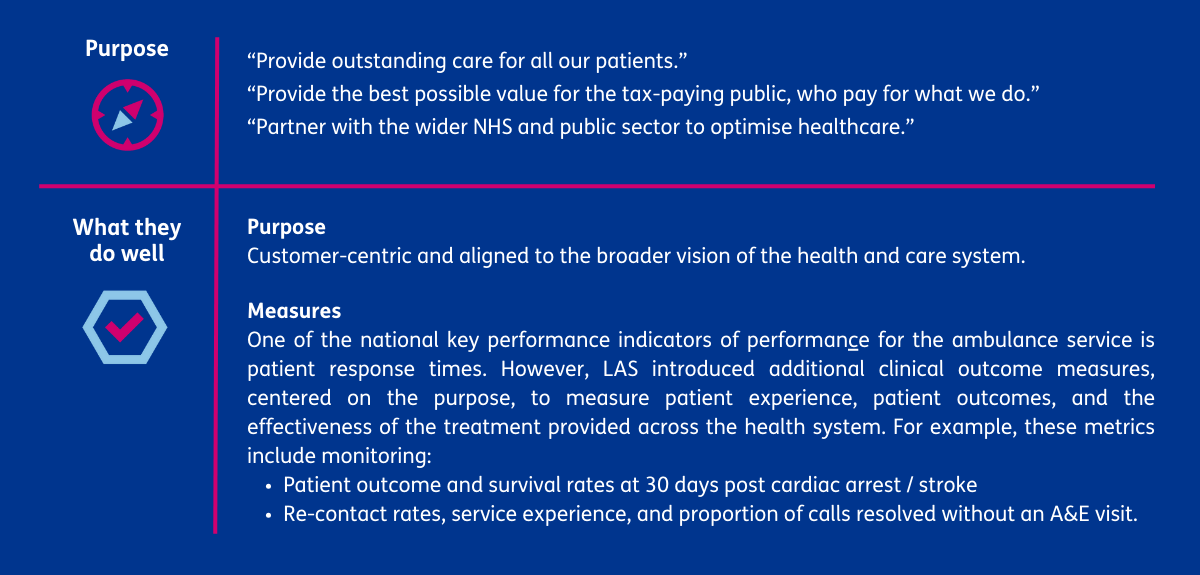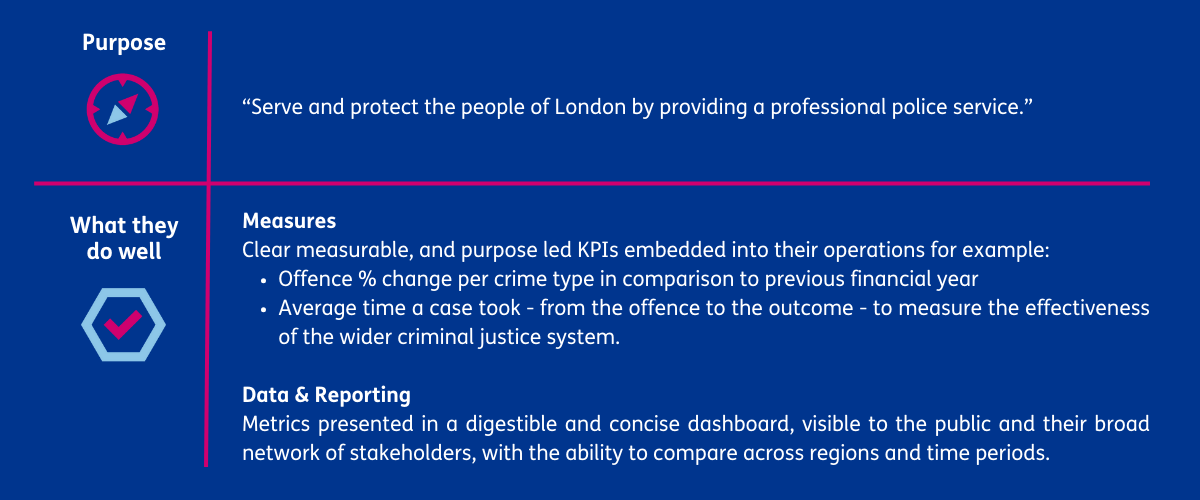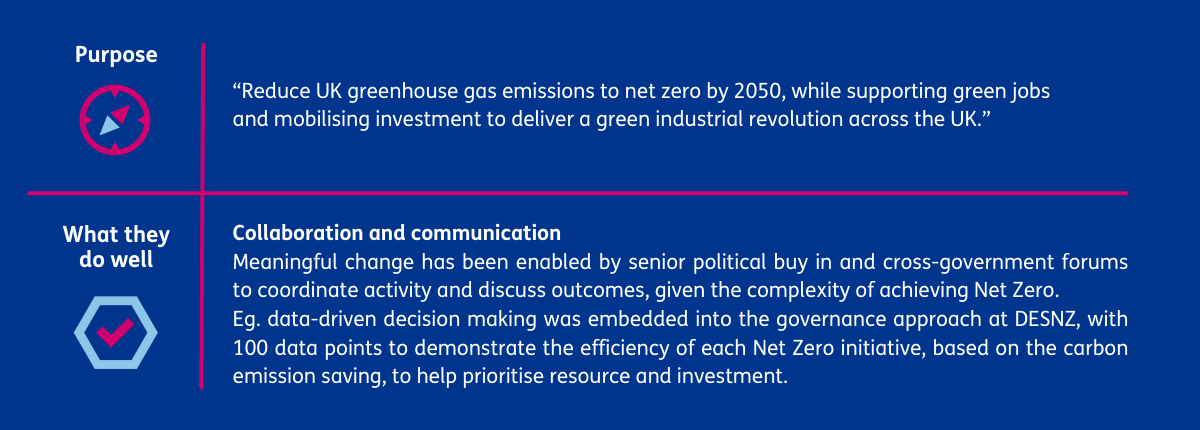
Leading with purpose: How the public sector can deliver better outcomes for society
Public sector productivity problems are systemic and demand for services is growing. Amid these pressures, governments need to become more agile to meet the diverse needs of citizens and adapt in the turbulent environment of national crises.
6 min read 28 January 2024
However, such changes are difficult to make. Public servants work in complex landscapes, with service delivery often requiring collaboration across disciplines, and increasingly across organisational boundaries. This was proven in the government’s response to the COVID-19 pandemic and exit the EU. The Institute for Government cites a lack of shared purpose, data sharing and governance structures as among the main barriers to collaboration in government.
Defining a clear purpose and measuring performance against this, establishes a meaningful direction for operational activity, leading to increasing transparency, accountability, and public trust. Furthermore, enhancing inter-agency collaboration and fostering a culture of shared purpose breaks down bureaucratic barriers, encouraging a more streamlined government machinery.
The benefits of this approach can be seen in looking at companies in the private sector. Companies with a clear purpose report 30% higher levels of innovation and outperform the stock market by 42%. Netflix, for example, has been anchored by its purpose to “entertain the world” and has been driven by data on how to achieve this since its inception. The founding principle of Netflix culture is autonomy, with the CEO striving to make as few decisions as possible and the Data Architecture Manager ensuring data is “accessible and visual, easy to discover and process for everyone”. As a result, Netflix is the industry leader, accounting for 17% of the global digital streaming market.
Purpose-led performance is a Baringa framework that puts purpose at the core of public service delivery. The framework helps organisations to define and measure the value of their work in relation to what matters most, and harness data to drive effective decision-making and to deliver better outcomes for the citizen.
In this article, we explore three levers to implement purpose-led performance:
- Purpose & Measures
- Data & Reporting
- Communication & Collaboration
Lever 1: Purpose and Measures
Align leadership with organisational purpose
Problems facing public sector organisations are often so complex that they defy simple solutions. Instead, they require leaders to navigate competing demands when making decisions.
Putting organisational purpose at the core of delivery, and empowering leaders to collaborate, and view problems as a part of a wider, dynamic system enables them to channel their resources and expertise towards goals that matter the most.
Three tips for defining organisational purpose:
-
Understand customers’ needs: Organisations must keep customers at the forefront of business decisions by understanding who they are and what they need. This should include research to gather insights into what users value and expect in public services.
-
Engage stakeholders across the end-to-end system: Public service delivery is dependent on many teams both within individual organisations and across government, and these teams should also play a part in helping to define organisational purpose to create a more comprehensive and inclusive understanding of the system.
-
Develop a concise purpose statement, to articulate why the service exists: A clear purpose helps stakeholders understand tangible goals and outcomes. A well-defined purpose statement should complement the strategic goals of the organisation, providing a clear path to achieving success.
Decide on measurable and purpose-led KPIs
Not everything that matters can be measured, and not everything that can be measured matters. Departments should articulate the outcomes they want to deliver for society, centred around their purpose and aligned to the strategic objectives of the organisation. Outcomes provide a clear and measurable picture of the success or failure of a service, helping to determine if efforts are achieving the desired results. Productivity gains come from both reducing inputs and improving output quality or quantity. We use the London Ambulance Service as an example of where this has worked well.
Three tips for establishing meaningful performance measures:
-
Focus on controllable outcomes: Government outcomes can be systematically complex and are affected by the interactions of several organisations. To make outcome measures tangible for improving performance, organisations must be able to connect them to inputs and outputs within their control. Once it is clear what needs to be measured, look at how to leverage data from a host of sources to track progress and don’t be constrained by the data currently available, there are often opportunities to leverage data from other sources to provide insights.
-
Understand the behaviours certain measures can drive: Inputs and outputs are important measures of progress and productivity, but focusing solely on them can be risky. Focus on utilisation (input) and activity (output) implies that leaders only care about quantity, which can reinforce the wrong behaviours across teams and often leads to a build-up in failure demand, resulting in poor customer satisfaction. Working to reduce failure demand is essentially about shifting the effort made in the organisation further towards value demand (what the customer really wants). As such, quality metrics are fundamental to measuring success and understanding if value has been delivered to the customer.
-
Engage the frontline: The best way to ensure ownership is to take part in creating it, and this is especially true for owning goals and performance measures. Frontline workers often have the most relevant knowledge about daily operations, challenges, and customer interactions, allowing them to provide valuable insights that ensure chosen metrics align closely with the intricacies of their roles and contribute effectively to organisational success.
Lever 2: Data and Reporting
Data empowers government leaders to address challenges proactively, respond to citizen needs effectively, and continually improve public service delivery. According to an HM Treasury and Cabinet Office survey, 62% of officials saw departmental unwillingness to share data across government as a major barrier to effective cross-government working.
Embedding purposeful data into operational delivery, across all levels, drives collaboration within and across government organisations, enables teams to identify bottlenecks and improvement opportunities, and ensures informed decision- making and efficient resource allocation. The example of the Metropolitan Police show these methods can be applied in a public service environment
Three tips for using analytics to improve performance management:
-
Empower teams with self-service visual analytics: Accelerate speed to insight by developing easy-to-use dashboards that clearly display performance and trends and enable decision-makers to set priorities and allocate resources based on the latest data. Ensure tools are fit for those at all levels of organisational management, making it easy for teams to understand how their work contributes to the overall purpose of the business. Encourage their active use by ensuring they are universally accessible and provide training to enable this.
-
Collaborate to turn data into actionable insights: Lean on those with domain knowledge, where required developing partnerships outside of your organisation, to help interpret data and better understand drivers behind performance. This will support the development of a rich performance narrative for reporting that highlights what is working well, and what needs to change to achieve targeted outcomes.
-
Embed products into performance cycles: Ensure dashboards are actively used to orient tactical and strategic decision-making. Use insight gained to determine specific business questions for leadership to answer in decision-making forums to ensure prioritisation of initiatives that add the most value, in keeping with the organisational purpose.
Lever 3: Communication and Collaboration
Increased transparency and continuous performance communication helps organisations monitor improvement plans and establish how service delivery is contributing to the organisation’s core objectives and fulfilling its purpose. In addition, cross-government collaboration can help create a community where the public and private sector can learn from each other about productivity barriers and improvements. For example, Baringa's work with Department for Energy Security and Net Zero (DESNZ) showcases the value of purpose-led communication and collaboration.
Three tips for achieving success through outcome-based thinking:
-
Use measures to drive continuous improvement towards targets: Outcomes measure the long-term effects of a process, task or activity and may not be directly observable. To monitor the effect of influencing outcomes, focus on positive change in the measures over time, and not on absolute numbers nor on comparisons to what other organisations are achieving. Influence is a process that takes time.
-
Allocate dedicated time for leadership to discuss performance: In the civil service, there are finite resources and ever-increasing demand on the system. Hence, it’s essential to make data-driven prioritisation calls, with input from leaders across the end-to-end system. Review existing governance structures and, where required, establish forums that provide a structured process for leaders to review system performance, track progress towards goals and work collectively to address priorities and cross-cutting strategic interests.
-
Promote end-to-end system success over individual team performance: Incentivising teams based on the success of the next step will drive more productive behaviours as it encourages employees to look beyond their immediate responsibilities and consider how their contributions impact the organisation’s ability to deliver value for the citizen. This commitment fosters a cohesive end-to-end system, driving productivity and innovation, as employees are inspired to find solutions to challenges in line with the overarching mission. Look out for our articles in March, which look in detail at how we can catalyse people-based change to drive productivity in government.
Conclusion
At Baringa, we believe the public sector should define and measure success by the impact on citizens and society, not just by the number of outputs produced. Our purpose-led performance approach enables government organisations to measure the value of their work in relation to their purpose and strategic objectives. It goes beyond individual tasks, considering the broader context and impact of performance, fostering a sense of shared purpose among public service employees, and enhancing citizen-centric service delivery.
As evidenced in our examples, organisations are often good at leveraging and embedding one of the three levers (purpose & measures, data & reporting, and communication & collaboration) for success. However, it is the combination of all three that truly drives productivity and efficiency.
We hope this article has inspired some thought on how starting with purpose and measuring what matters are critical first steps to driving meaningful outcomes that align with the needs and aspirations of society.
Get in touch
To find out how Baringa could help your organisation unlock productivity improvements through a more outcome-focused approach, please contact our experts Matt Jones or Robyn Turl.
Our Experts


Related Insights

Baringa Matrix of Health Productivity
Discover our recommendations for both long term opportunities and quick wins that NHS leaders should consider.
Read more
A productive conversation about productivity – what’s next for the NHS?
Discover what could be done to address the NHS productivity puzzle.
Read more
How can the new Government ensure value for money?
Discover the four ways the Treasury could drive better value for money outcomes.
Read more
What will increasing automation mean for civil service leaders of the future?
Matt Jones and his guests explore automation in Government, what automation means for the people who work on operating our public services, and the risks of bringing AI into organisations.
Read moreRelated Client Stories

Improving data preparation and collection for better State Government decisions
How do you collect and translate inconsistent data from disparate systems to better inform and evaluate the impact of spend policies?
Read more
Putting a social outcomes lens over an IT RFP for an Australian government agency
How do you change how vendors see their systems, so responses align with agency outcomes and non-functional requirements?
Read more
Ensuring climate compliance and lasting impact for government agencies
How do government agencies navigate climate regulations today and future-proof for tomorrow?
Read more
Delivering NHS England’s most complex non-clinical technology procurement ever
Supporting NHS England build the data backbone that will unlock better health services and care for people in England for years to come.
Read moreIs digital and AI delivering what your business needs?
Digital and AI can solve your toughest challenges and elevate your business performance. But success isn’t always straightforward. Where can you unlock opportunity? And what does it take to set the foundation for lasting success?


